1, Writing examples
1. Server
pom.xml
<properties>
<java.version>1.8</java.version>
<spring-cloud.version>Finchley.SR2</spring-cloud.version>
</properties>
<dependencies>
<dependency>
<groupId>org.springframework.boot</groupId>
<artifactId>spring-boot-starter-actuator</artifactId>
</dependency>
<dependency>
<groupId>org.springframework.cloud</groupId>
<artifactId>spring-cloud-starter-alibaba-nacos-discovery</artifactId>
</dependency>
<dependency>
<groupId>org.springframework.boot</groupId>
<artifactId>spring-boot-starter-web</artifactId>
</dependency>
<dependency>
<groupId>org.projectlombok</groupId>
<artifactId>lombok</artifactId>
</dependency>
<dependency>
<groupId>org.springframework.boot</groupId>
<artifactId>spring-boot-starter-test</artifactId>
<scope>test</scope>
</dependency>
</dependencies>
<dependencyManagement>
<dependencies>
<dependency>
<groupId>org.springframework.cloud</groupId>
<artifactId>spring-cloud-dependencies</artifactId>
<version>${spring-cloud.version}</version>
<type>pom</type>
<scope>import</scope>
</dependency>
<dependency>
<groupId>org.springframework.cloud</groupId>
<artifactId>spring-cloud-alibaba-dependencies</artifactId>
<version>0.2.1.RELEASE</version>
<type>pom</type>
<scope>import</scope>
</dependency>
</dependencies>
</dependencyManagement>2. The provider code is an ordinary HTTP REST interface.
@SpringBootApplication
@EnableDiscoveryClient
@RestController
@Slf4j
public class ProviderApplication {
public static void main(String[] args) {
SpringApplication.run(ProviderApplication.class, args);
}
@GetMapping("provider")
public String provider(){
log.info("..................................");
return "hello,provider";
}
}
3. Consumer side
POM
<properties>
<java.version>1.8</java.version>
<spring-cloud.version>Finchley.SR2</spring-cloud.version>
</properties>
<dependencies>
<dependency>
<groupId>org.springframework.boot</groupId>
<artifactId>spring-boot-starter-actuator</artifactId>
<exclusions>
<exclusion>
<groupId>org.springframework.retry</groupId>
<artifactId>spring-retry</artifactId>
</exclusion>
</exclusions>
</dependency>
<dependency>
<groupId>org.springframework.cloud</groupId>
<artifactId>spring-cloud-starter-alibaba-nacos-discovery</artifactId>
</dependency>
<dependency>
<groupId>org.springframework.boot</groupId>
<artifactId>spring-boot-starter-web</artifactId>
</dependency>
<!-- <dependency>-->
<!-- <groupId>org.springframework.retry</groupId>-->
<!-- <artifactId>spring-retry</artifactId>-->
<!-- </dependency>-->
<dependency>
<groupId>org.projectlombok</groupId>
<artifactId>lombok</artifactId>
</dependency>
<!--<dependency>-->
<!--<groupId>org.springframework.retry</groupId>-->
<!--<artifactId>spring-retry</artifactId>-->
<!--</dependency>-->
<dependency>
<groupId>org.springframework.boot</groupId>
<artifactId>spring-boot-starter-test</artifactId>
<scope>test</scope>
</dependency>
</dependencies>
<dependencyManagement>
<dependencies>
<dependency>
<groupId>org.springframework.cloud</groupId>
<artifactId>spring-cloud-dependencies</artifactId>
<version>${spring-cloud.version}</version>
<type>pom</type>
<scope>import</scope>
</dependency>
<dependency>
<groupId>org.springframework.cloud</groupId>
<artifactId>spring-cloud-alibaba-dependencies</artifactId>
<version>0.2.1.RELEASE</version>
<type>pom</type>
<scope>import</scope>
</dependency>
</dependencies>
</dependencyManagement>Note here that if you do not want the RetryTemplate, remove the dependency of Retry, otherwise it will be introduced by default.
Consumer code
@SpringBootApplication
@Slf4j
@EnableDiscoveryClient
@RestController
public class ConsumeApplication {
@Autowired
RestTemplate restTemplate;
@Bean
@LoadBalanced
public RestTemplate getRestTemplate(){
HttpComponentsClientHttpRequestFactory clientHttpRequestFactory = new HttpComponentsClientHttpRequestFactory();
clientHttpRequestFactory.setConnectTimeout(5 * 1000);
clientHttpRequestFactory.setReadTimeout(5 * 1000);
return new RestTemplate(clientHttpRequestFactory);
}
public static void main(String[] args) {
SpringApplication.run(ConsumeApplication.class, args);
}
@GetMapping("test")
public String getContent(){
log.info("Initiate request");
return restTemplate.getForObject("http://provider/provider",String.class);
}
}
2, Initialize autoconfiguration code analysis
1.org.springframework.cloud.netflix.ribbon.RibbonAutoConfiguration, which is private to RIBBON
Initialization of loadbalancerclient, loadbalancer and iRule objects.
@Configuration
@ConditionalOnClass({ IClient.class, RestTemplate.class, AsyncRestTemplate.class, Ribbon.class})
@RibbonClients
@AutoConfigureAfter(name = "org.springframework.cloud.netflix.eureka.EurekaClientAutoConfiguration")
@AutoConfigureBefore({LoadBalancerAutoConfiguration.class, AsyncLoadBalancerAutoConfiguration.class})
@EnableConfigurationProperties({RibbonEagerLoadProperties.class, ServerIntrospectorProperties.class})
public class RibbonAutoConfiguration {
@Bean
public SpringClientFactory springClientFactory() {
SpringClientFactory factory = new SpringClientFactory();
factory.setConfigurations(this.configurations);
return factory;
}
@Bean
@ConditionalOnMissingBean(LoadBalancerClient.class)
public LoadBalancerClient loadBalancerClient() {
return new RibbonLoadBalancerClient(springClientFactory());
}
@Bean
@ConditionalOnClass(name = "org.springframework.retry.support.RetryTemplate")
@ConditionalOnMissingBean
public LoadBalancedRetryFactory loadBalancedRetryPolicyFactory(final SpringClientFactory clientFactory) {
return new RibbonLoadBalancedRetryFactory(clientFactory);
}
2.org. springframework. cloud. client. loadbalancer. Loadbalancenautoconfiguration is automatically initialized for the object of springcloud common.
@Configuration
@ConditionalOnClass(RestTemplate.class)
@ConditionalOnBean(LoadBalancerClient.class)
@EnableConfigurationProperties(LoadBalancerRetryProperties.class)
public class LoadBalancerAutoConfiguration {
@LoadBalanced
@Autowired(required = false)
private List<RestTemplate> restTemplates = Collections.emptyList();
@Bean
public SmartInitializingSingleton loadBalancedRestTemplateInitializerDeprecated(
final ObjectProvider<List<RestTemplateCustomizer>> restTemplateCustomizers) {
return () -> restTemplateCustomizers.ifAvailable(customizers -> {
for (RestTemplate restTemplate : LoadBalancerAutoConfiguration.this.restTemplates) {
for (RestTemplateCustomizer customizer : customizers) {
customizer.customize(restTemplate);
}
}
});
}
@Autowired(required = false)
private List<LoadBalancerRequestTransformer> transformers = Collections.emptyList();
@Bean
@ConditionalOnMissingBean
public LoadBalancerRequestFactory loadBalancerRequestFactory(
LoadBalancerClient loadBalancerClient) {
return new LoadBalancerRequestFactory(loadBalancerClient, transformers);
}
@Configuration
@ConditionalOnMissingClass("org.springframework.retry.support.RetryTemplate")
static class LoadBalancerInterceptorConfig {
@Bean
public LoadBalancerInterceptor ribbonInterceptor(
LoadBalancerClient loadBalancerClient,
LoadBalancerRequestFactory requestFactory) {
return new LoadBalancerInterceptor(loadBalancerClient, requestFactory);
}
@Bean
@ConditionalOnMissingBean
public RestTemplateCustomizer restTemplateCustomizer(
final LoadBalancerInterceptor loadBalancerInterceptor) {
return restTemplate -> {
List<ClientHttpRequestInterceptor> list = new ArrayList<>(
restTemplate.getInterceptors());
list.add(loadBalancerInterceptor);
restTemplate.setInterceptors(list);
};
}
}The restTemplate here will only take those annotated with @ LoadBalance, because @ loader is added with @ qualifier, which will filter.
If you remove the RetryTemplate, you will go to the default, otherwise go to retry balance
1. First create the LoadBalancerRequestFactory factory object.

2. Create LoadBalancerInterceptor object

3. Set the interceptor property for the RestTemplate list object.

3, Call analysis
1. RestTemplate. The GetObject method starts. This method calls doExecute
public class RestTemplate extends InterceptingHttpAccessor implements RestOperations {
@Nullable
protected <T> T doExecute(URI url, @Nullable HttpMethod method, @Nullable RequestCallback requestCallback,
@Nullable ResponseExtractor<T> responseExtractor) throws RestClientException {
Assert.notNull(url, "URI is required");
Assert.notNull(method, "HttpMethod is required");
ClientHttpResponse response = null;
try {
ClientHttpRequest request = createRequest(url, method);
if (requestCallback != null) {
requestCallback.doWithRequest(request);
}
response = request.execute();
handleResponse(url, method, response);
return (responseExtractor != null ? responseExtractor.extractData(response) : null);
}
catch (IOException ex) {
String resource = url.toString();
String query = url.getRawQuery();
resource = (query != null ? resource.substring(0, resource.indexOf('?')) : resource);
throw new ResourceAccessException("I/O error on " + method.name() +
" request for \"" + resource + "\": " + ex.getMessage(), ex);
}
finally {
if (response != null) {
response.close();
}
}
} 
2.createRequest method, RestTemplate is inherited from interceptinghttaccessor and HttpAccessor

HttpAccessor
protected ClientHttpRequest createRequest(URI url, HttpMethod method) throws IOException {
ClientHttpRequest request = getRequestFactory().createRequest(url, method);
if (logger.isDebugEnabled()) {
logger.debug("Created " + method.name() + " request for \"" + url + "\"");
}
return request;
}3. The getrequestfactory method is derived from InterceptingHttpAccessor, where the original httpRequestFactory factory will be wrapped.
public ClientHttpRequestFactory getRequestFactory() {
List<ClientHttpRequestInterceptor> interceptors = getInterceptors();
if (!CollectionUtils.isEmpty(interceptors)) {
ClientHttpRequestFactory factory = this.interceptingRequestFactory;
if (factory == null) {
factory = new InterceptingClientHttpRequestFactory(super.getRequestFactory(), interceptors);
this.interceptingRequestFactory = factory;
}
return factory;
}
else {
return super.getRequestFactory();
}
}
public class InterceptingClientHttpRequestFactory extends AbstractClientHttpRequestFactoryWrapper {
private final List<ClientHttpRequestInterceptor> interceptors;
/**
* Create a new instance of the {@code InterceptingClientHttpRequestFactory} with the given parameters.
* @param requestFactory the request factory to wrap
* @param interceptors the interceptors that are to be applied (can be {@code null})
*/
public InterceptingClientHttpRequestFactory(ClientHttpRequestFactory requestFactory,
@Nullable List<ClientHttpRequestInterceptor> interceptors) {
super(requestFactory);
this.interceptors = (interceptors != null ? interceptors : Collections.emptyList());
}
@Override
protected ClientHttpRequest createRequest(URI uri, HttpMethod httpMethod, ClientHttpRequestFactory requestFactory) {
return new InterceptingClientHttpRequest(requestFactory, this.interceptors, uri, httpMethod);
}
}
So the final ClientHttpRequest is InterceptingClientHttpRequest

3. Then we return to the first step, response = request execute(); Since the request has been created, start execution now.
class InterceptingClientHttpRequest extends AbstractBufferingClientHttpRequest {
private final ClientHttpRequestFactory requestFactory;
private final List<ClientHttpRequestInterceptor> interceptors;
private HttpMethod method;
private URI uri;
protected InterceptingClientHttpRequest(ClientHttpRequestFactory requestFactory,
List<ClientHttpRequestInterceptor> interceptors, URI uri, HttpMethod method) {
this.requestFactory = requestFactory;
this.interceptors = interceptors;
this.method = method;
this.uri = uri;
}
@Override
public HttpMethod getMethod() {
return this.method;
}
@Override
public String getMethodValue() {
return this.method.name();
}
@Override
public URI getURI() {
return this.uri;
}
@Override
protected final ClientHttpResponse executeInternal(HttpHeaders headers, byte[] bufferedOutput) throws IOException {
InterceptingRequestExecution requestExecution = new InterceptingRequestExecution();
return requestExecution.execute(this, bufferedOutput);
}
private class InterceptingRequestExecution implements ClientHttpRequestExecution {
private final Iterator<ClientHttpRequestInterceptor> iterator;
public InterceptingRequestExecution() {
this.iterator = interceptors.iterator();
}
@Override
public ClientHttpResponse execute(HttpRequest request, byte[] body) throws IOException {
if (this.iterator.hasNext()) {
ClientHttpRequestInterceptor nextInterceptor = this.iterator.next();
return nextInterceptor.intercept(request, body, this);
}
else {
HttpMethod method = request.getMethod();
Assert.state(method != null, "No standard HTTP method");
ClientHttpRequest delegate = requestFactory.createRequest(request.getURI(), method);
request.getHeaders().forEach((key, value) -> delegate.getHeaders().addAll(key, value));
if (body.length > 0) {
if (delegate instanceof StreamingHttpOutputMessage) {
StreamingHttpOutputMessage streamingOutputMessage = (StreamingHttpOutputMessage) delegate;
streamingOutputMessage.setBody(outputStream -> StreamUtils.copy(body, outputStream));
}
else {
StreamUtils.copy(body, delegate.getBody());
}
}
return delegate.execute();
}
}
}
}
InterceptingClientHttpRequest's execute executes the executeInternel method, and finally calls.
InterceptingRequestExecution.execute

InterceptingRequestExecution. The execute method will first call various interceptors for processing. After processing, the interceptor will call the execute method of this object again to make the responsibility chain mode. Finally, the default HTTP agent is invoked to request the factory to generate the proxy object to initiate the HTTP request.
The current interceptor is to obtain the instance address from the registry and replace the URL
4. Proceed to loadbalancerinterceptor Interrupt method.
public class LoadBalancerInterceptor implements ClientHttpRequestInterceptor {
private LoadBalancerClient loadBalancer;
private LoadBalancerRequestFactory requestFactory;
public LoadBalancerInterceptor(LoadBalancerClient loadBalancer, LoadBalancerRequestFactory requestFactory) {
this.loadBalancer = loadBalancer;
this.requestFactory = requestFactory;
}
public LoadBalancerInterceptor(LoadBalancerClient loadBalancer) {
// for backwards compatibility
this(loadBalancer, new LoadBalancerRequestFactory(loadBalancer));
}
@Override
public ClientHttpResponse intercept(final HttpRequest request, final byte[] body,
final ClientHttpRequestExecution execution) throws IOException {
final URI originalUri = request.getURI();
String serviceName = originalUri.getHost();
return this.loadBalancer.execute(serviceName, requestFactory.createRequest(request, body, execution));
}
}
5. The loadBalancer here is the RibbonLoadBalancerClient, so call this to replace the URL.
public class RibbonLoadBalancerClient implements LoadBalancerClient {
private SpringClientFactory clientFactory;
public RibbonLoadBalancerClient(SpringClientFactory clientFactory) {
this.clientFactory = clientFactory;
}
@Override
public URI reconstructURI(ServiceInstance instance, URI original) {
Assert.notNull(instance, "instance can not be null");
String serviceId = instance.getServiceId();
RibbonLoadBalancerContext context = this.clientFactory
.getLoadBalancerContext(serviceId);
URI uri;
Server server;
if (instance instanceof RibbonServer) {
RibbonServer ribbonServer = (RibbonServer) instance;
server = ribbonServer.getServer();
uri = updateToSecureConnectionIfNeeded(original, ribbonServer);
} else {
server = new Server(instance.getScheme(), instance.getHost(), instance.getPort());
IClientConfig clientConfig = clientFactory.getClientConfig(serviceId);
ServerIntrospector serverIntrospector = serverIntrospector(serviceId);
uri = updateToSecureConnectionIfNeeded(original, clientConfig,
serverIntrospector, server);
}
return context.reconstructURIWithServer(server, uri);
}
@Override
public ServiceInstance choose(String serviceId) {
Server server = getServer(serviceId);
if (server == null) {
return null;
}
return new RibbonServer(serviceId, server, isSecure(server, serviceId),
serverIntrospector(serviceId).getMetadata(server));
}
@Override
public <T> T execute(String serviceId, LoadBalancerRequest<T> request) throws IOException {
ILoadBalancer loadBalancer = getLoadBalancer(serviceId);
Server server = getServer(loadBalancer);
if (server == null) {
throw new IllegalStateException("No instances available for " + serviceId);
}
RibbonServer ribbonServer = new RibbonServer(serviceId, server, isSecure(server,
serviceId), serverIntrospector(serviceId).getMetadata(server));
return execute(serviceId, ribbonServer, request);
}6. Then call ribbonloadbalancerclient Getloadbalancer gets the load balancer.

7.SpringClientFactory.getLoadBalancer
return getInstance(name, ILoadBalancer.class); This will go to the container factory to automatically create and obtain the iloadbalancer class.

8. Ribbonloadbalanceinghttpclient is the implementation class.
package org.springframework.cloud.netflix.ribbon.apache;
/**
* @author Spencer Gibb
*/
@Configuration
@ConditionalOnClass(name = "org.apache.http.client.HttpClient")
@ConditionalOnProperty(name = "ribbon.httpclient.enabled", matchIfMissing = true)
public class HttpClientRibbonConfiguration {
@Bean
@ConditionalOnMissingBean(AbstractLoadBalancerAwareClient.class)
@ConditionalOnMissingClass(value = "org.springframework.retry.support.RetryTemplate")
public RibbonLoadBalancingHttpClient ribbonLoadBalancingHttpClient(
IClientConfig config, ServerIntrospector serverIntrospector,
ILoadBalancer loadBalancer, RetryHandler retryHandler, CloseableHttpClient httpClient) {
RibbonLoadBalancingHttpClient client = new RibbonLoadBalancingHttpClient(httpClient, config, serverIntrospector);
client.setLoadBalancer(loadBalancer);
client.setRetryHandler(retryHandler);
Monitors.registerObject("Client_" + this.name, client);
return client;
}9. This depends on the ribbonLoadBalancer, which is actually the class zoneawarelooadbalancer
package org.springframework.cloud.netflix.ribbon;
/**
* @author Dave Syer
* @author Tim Ysewyn
*/
@SuppressWarnings("deprecation")
@Configuration
@EnableConfigurationProperties
//Order is important here, last should be the default, first should be optional
// see https://github.com/spring-cloud/spring-cloud-netflix/issues/2086#issuecomment-316281653
@Import({HttpClientConfiguration.class, OkHttpRibbonConfiguration.class, RestClientRibbonConfiguration.class, HttpClientRibbonConfiguration.class})
public class RibbonClientConfiguration {
@Bean
@ConditionalOnMissingBean
public ILoadBalancer ribbonLoadBalancer(IClientConfig config,
ServerList<Server> serverList, ServerListFilter<Server> serverListFilter,
IRule rule, IPing ping, ServerListUpdater serverListUpdater) {
if (this.propertiesFactory.isSet(ILoadBalancer.class, name)) {
return this.propertiesFactory.get(ILoadBalancer.class, config, name);
}
return new ZoneAwareLoadBalancer<>(config, rule, ping, serverList,
serverListFilter, serverListUpdater);
}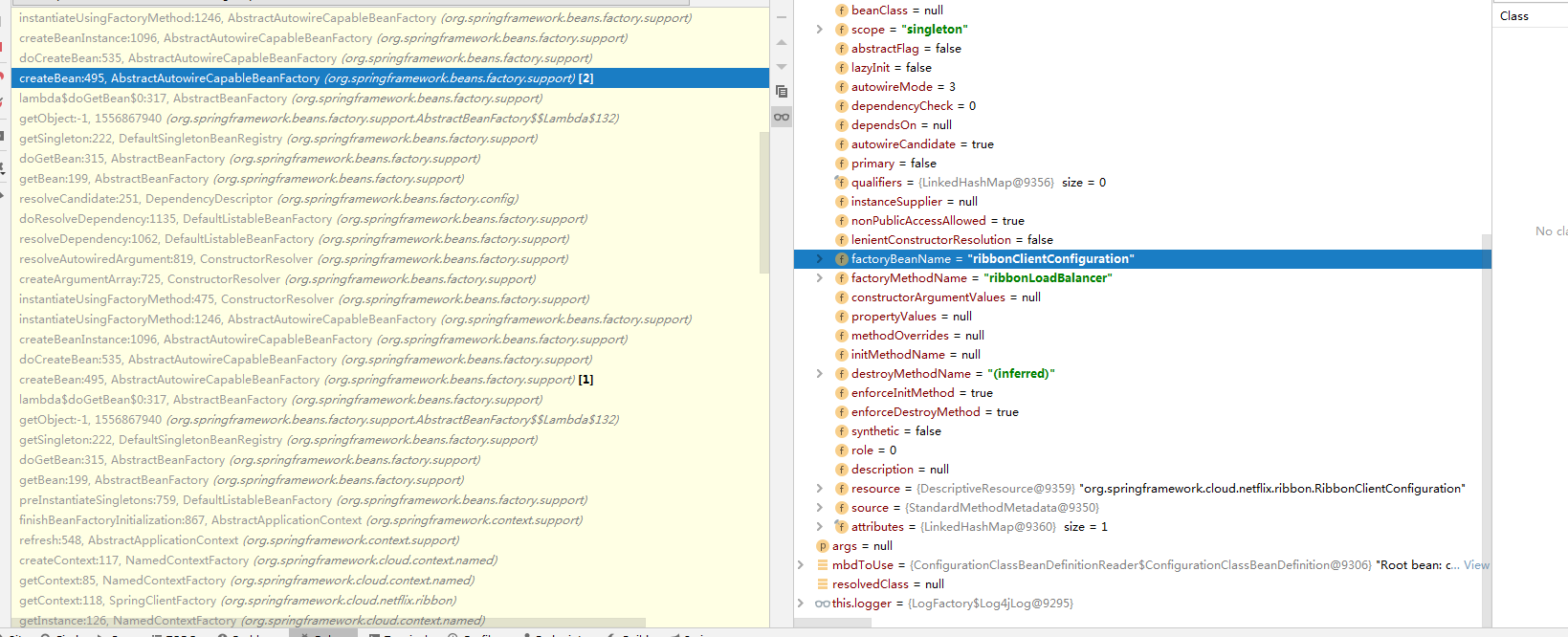
10. The above class depends on IRULE, so finally create} ribbonRule, and the implementation class is
ZoneAvoidanceRule


11. After creating the RULE, create the loadBalance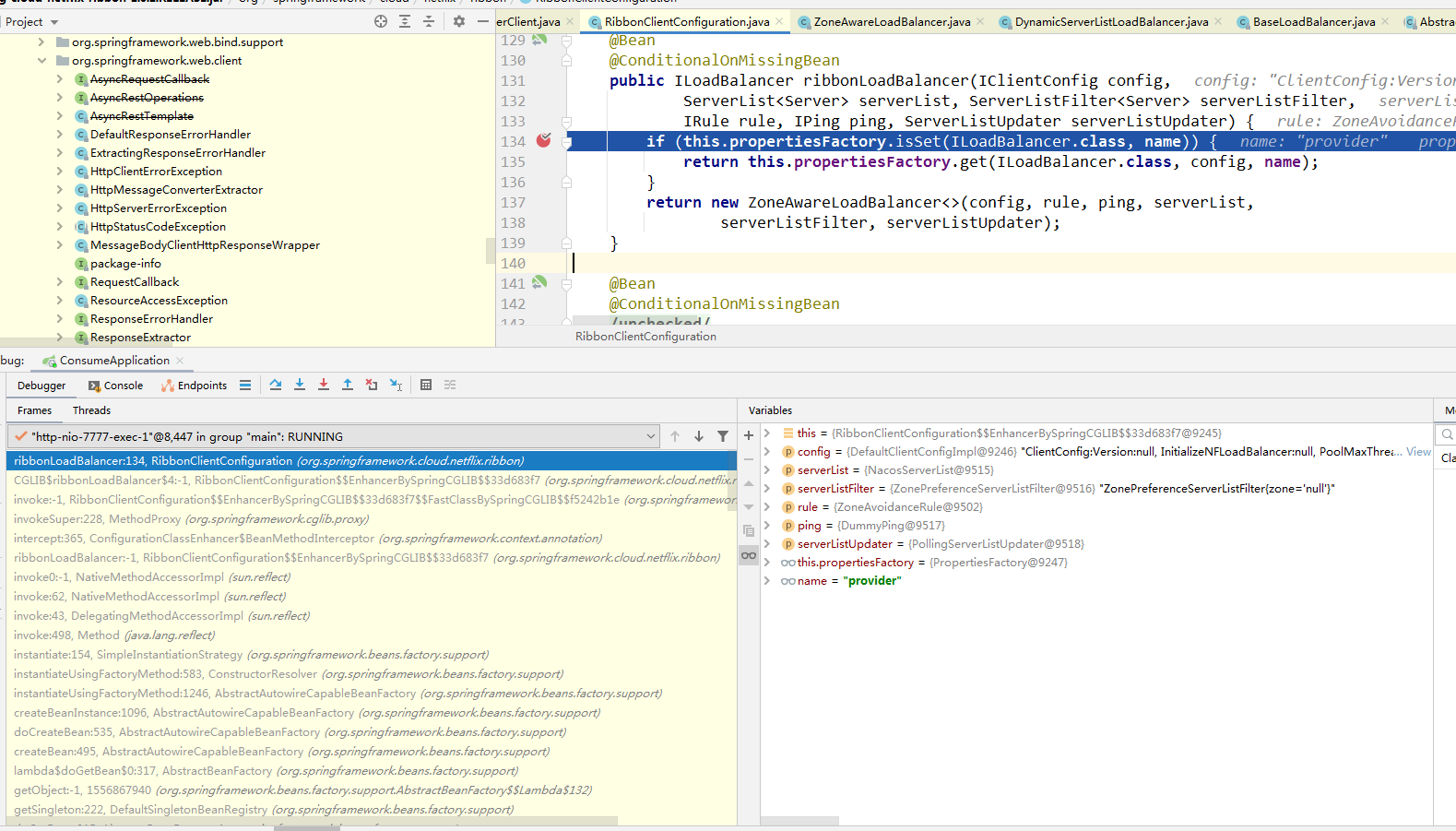
12. Create ribbonLoadBalancer
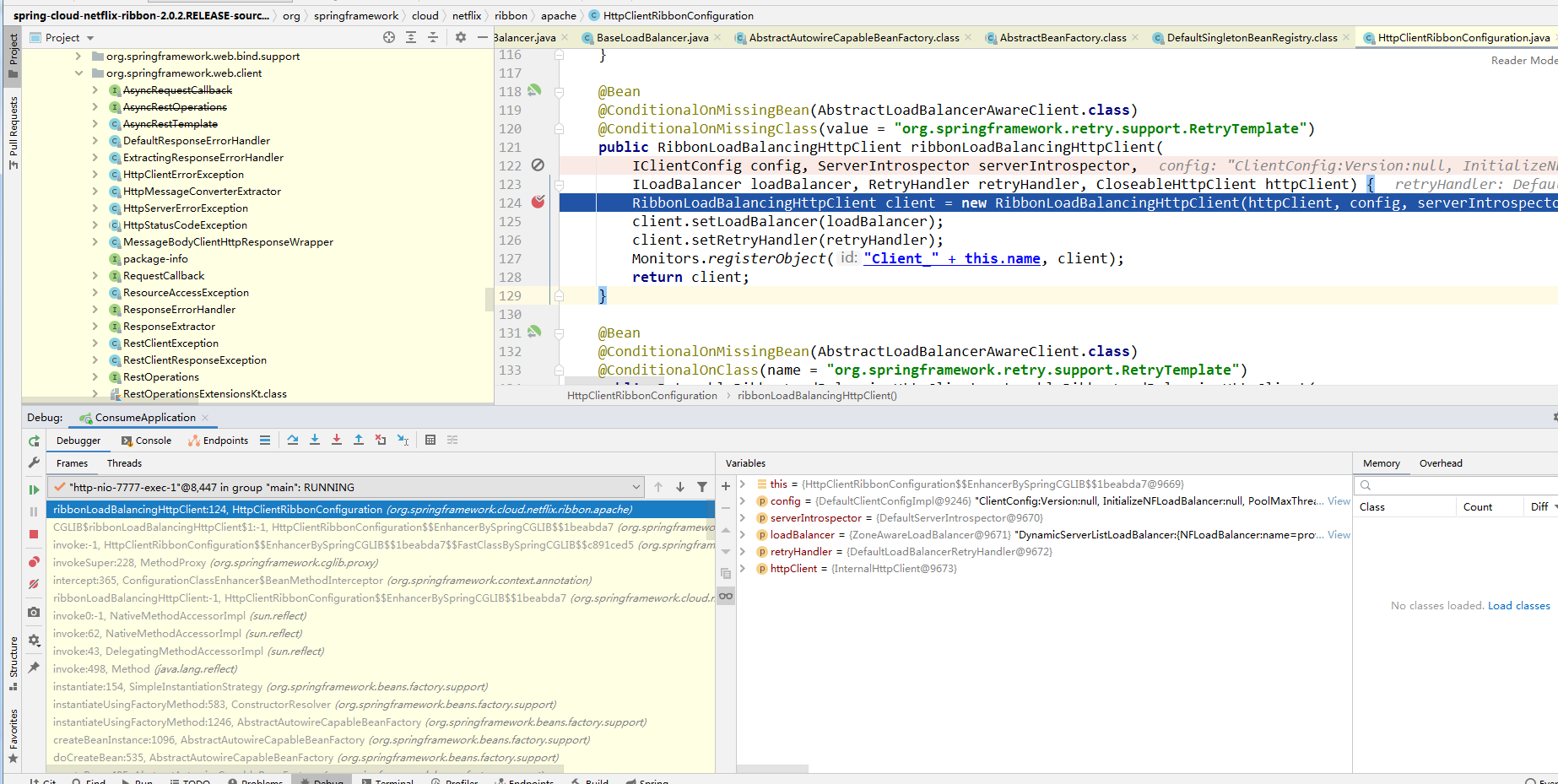
13. Let's go back to step 5, @ Override
public <T> T execute(String serviceId, LoadBalancerRequest<T> request) throws IOException {
ILoadBalancer loadBalancer = getLoadBalancer(serviceId);
Server server = getServer(loadBalancer);, Start getting server
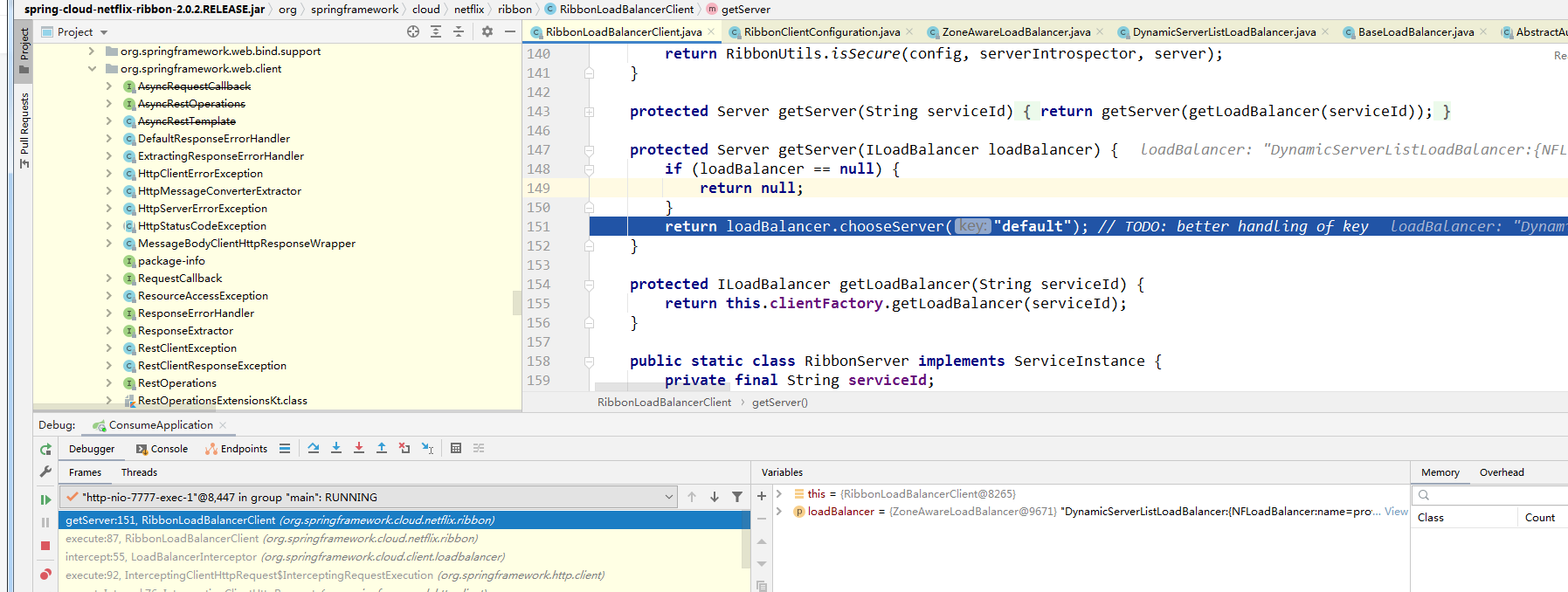
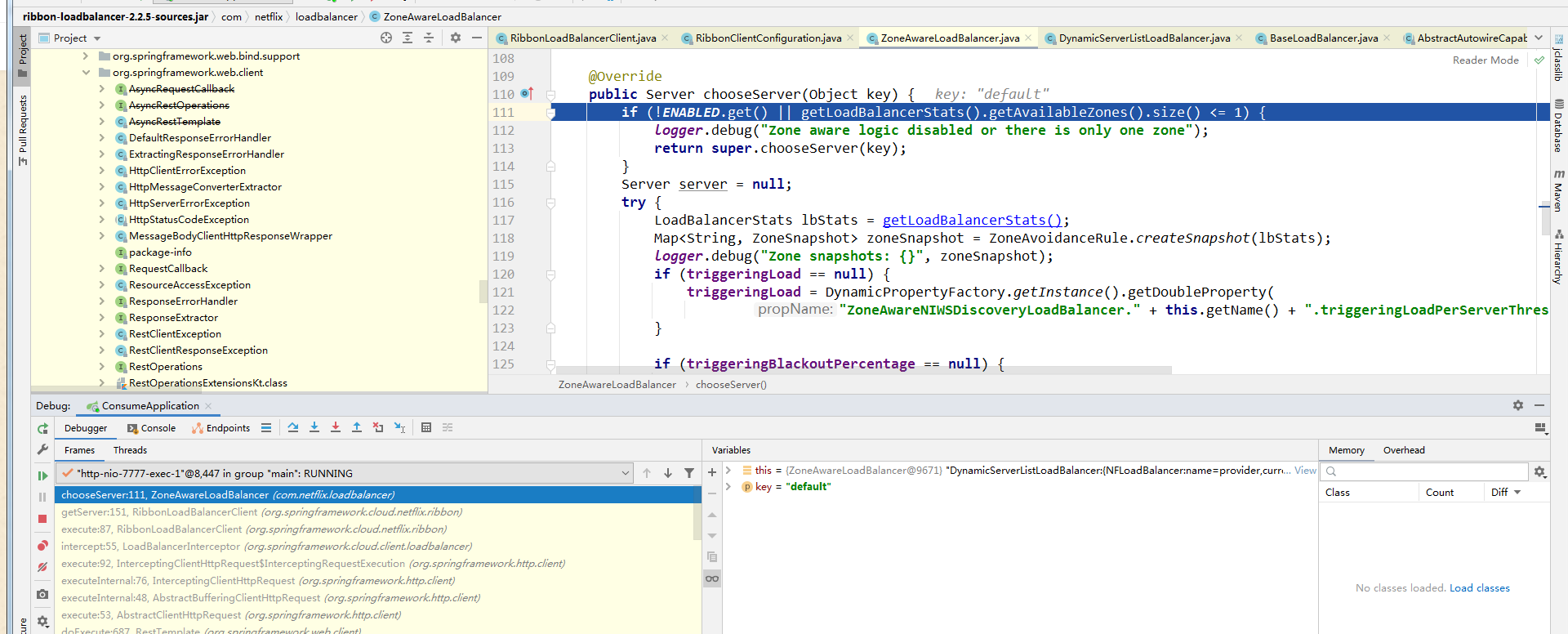
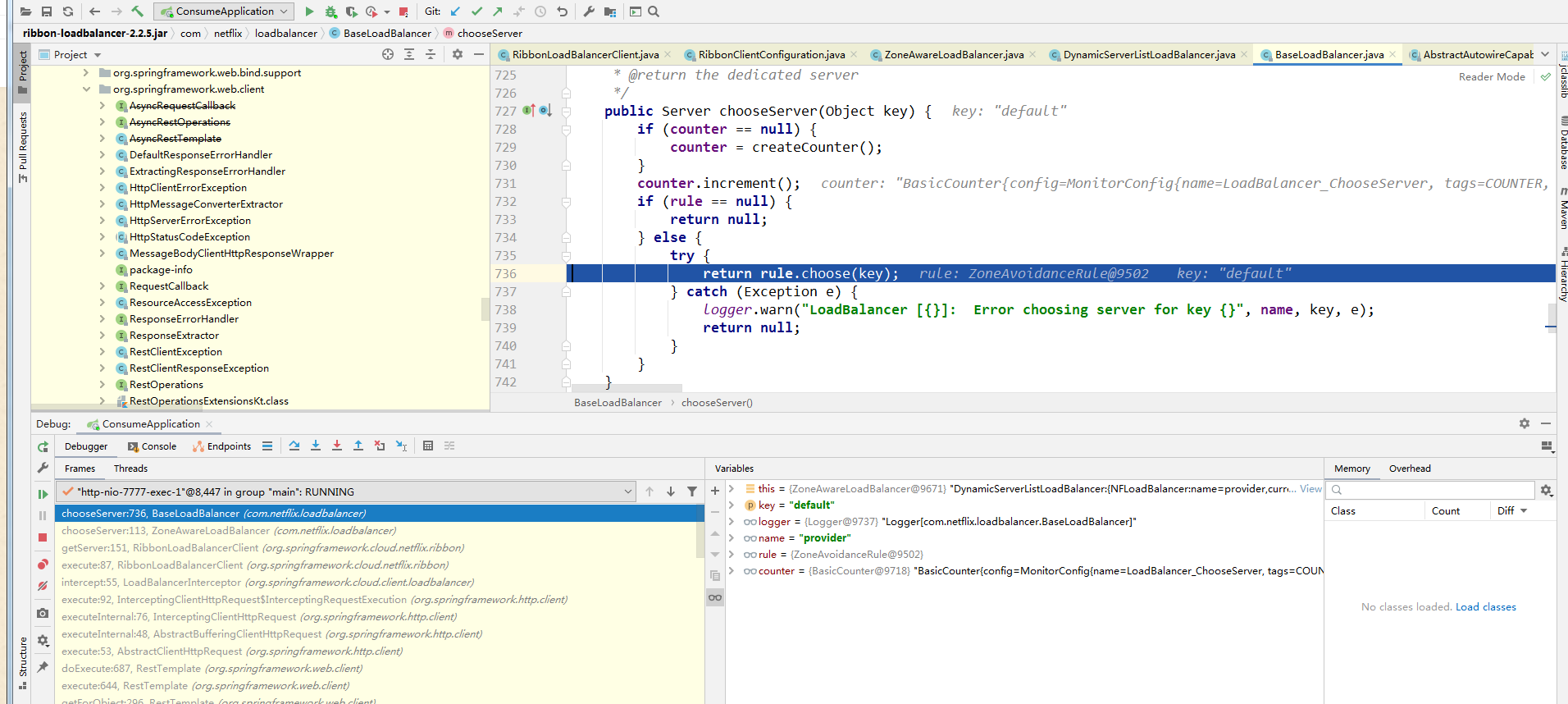
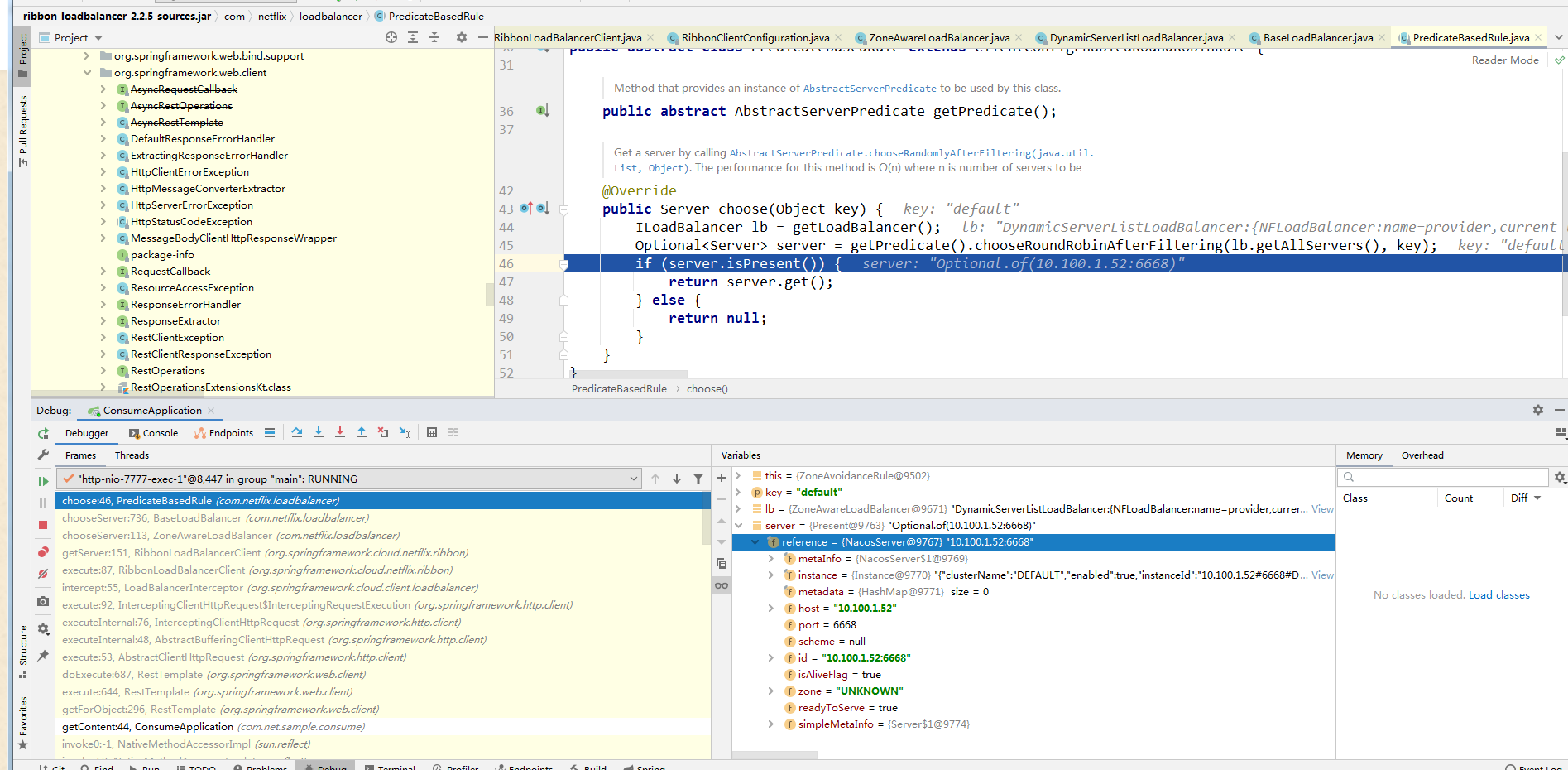
14. Select the server and start execution.
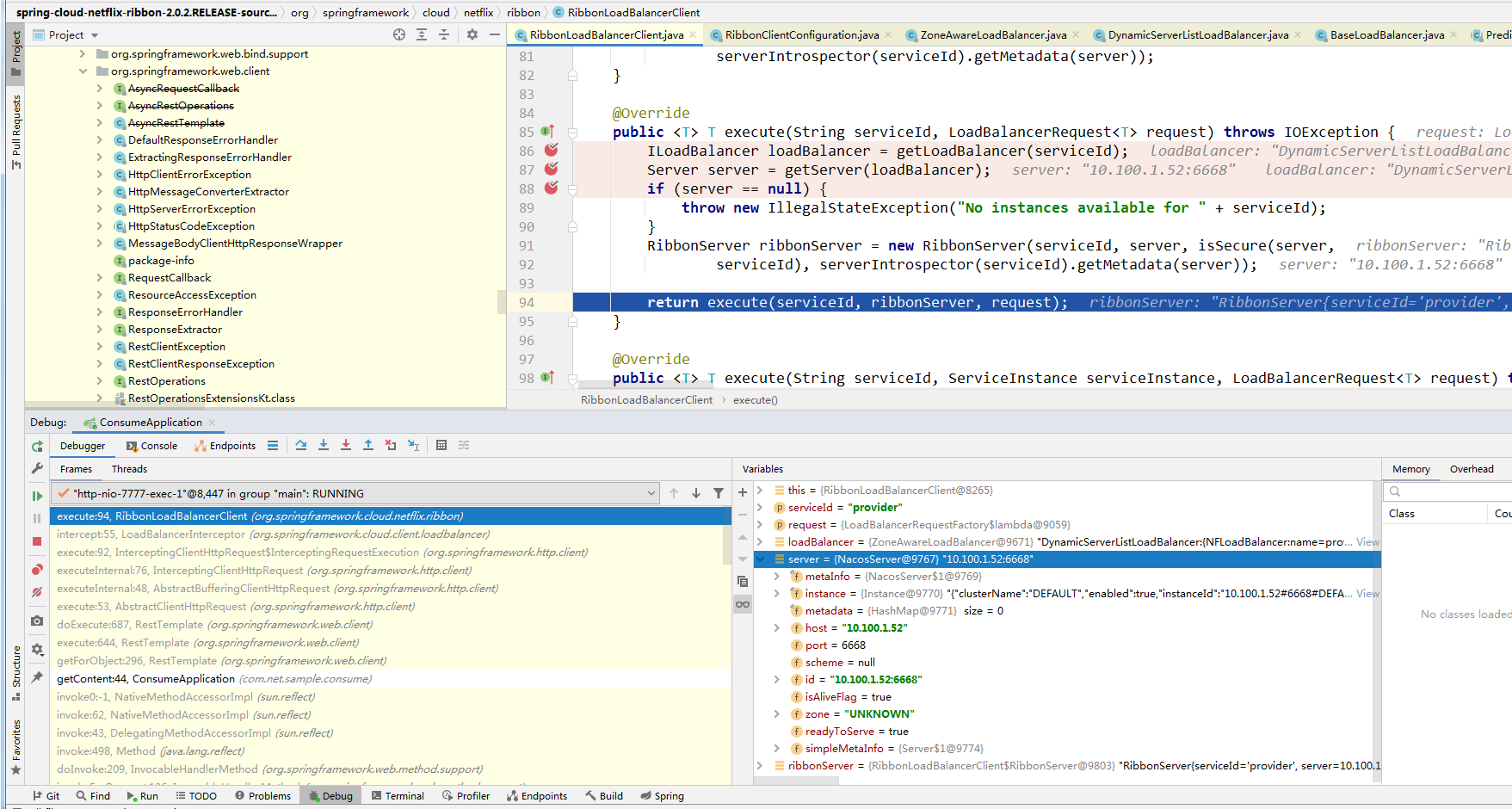
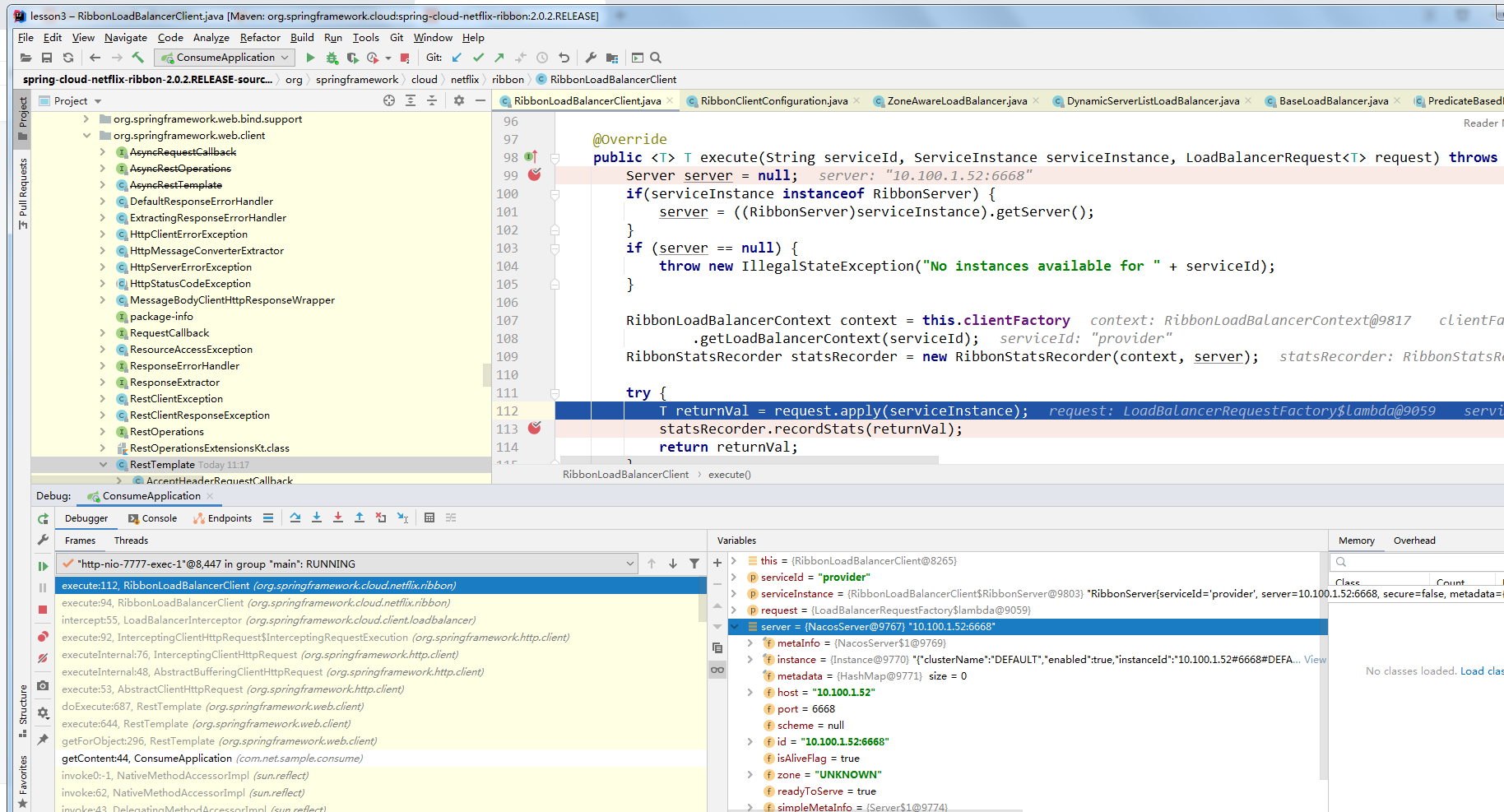
15. Go back to loadbalancerrequestfactory apply
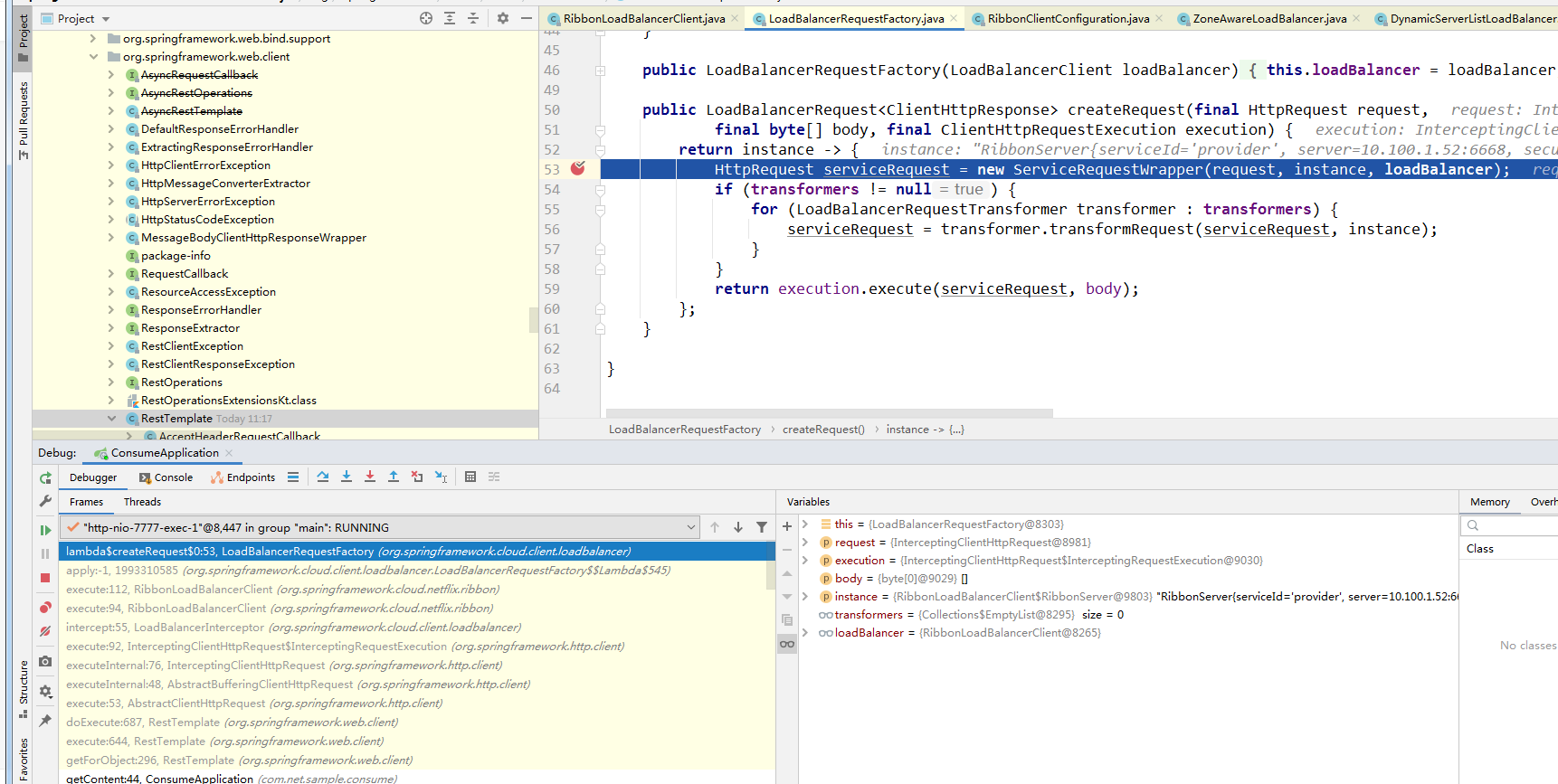
16. Back to intercepting request execution execute
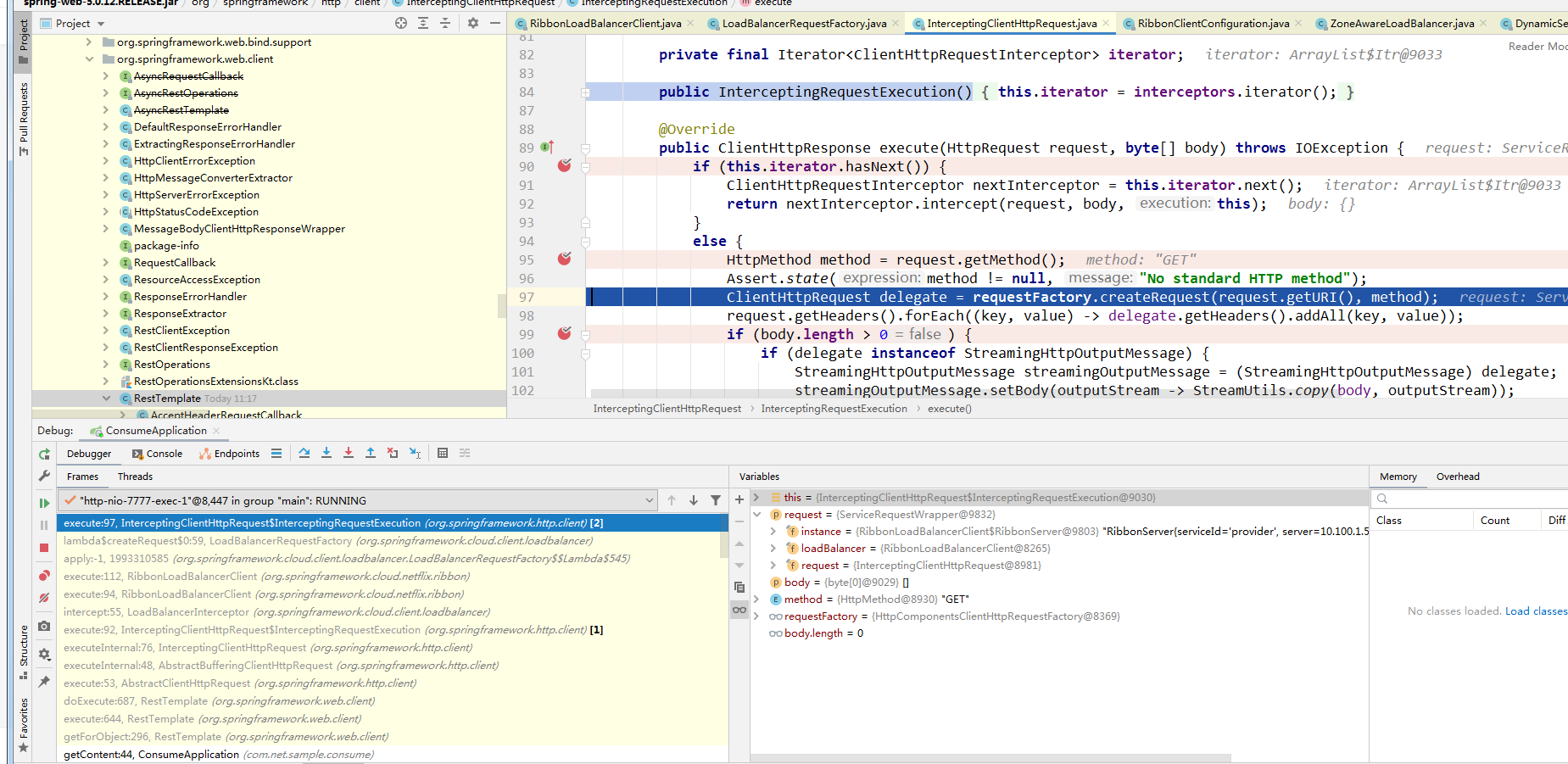
17. Next, start replacing the URL

18. RibbonLoadBalancerClient.reconstructURI
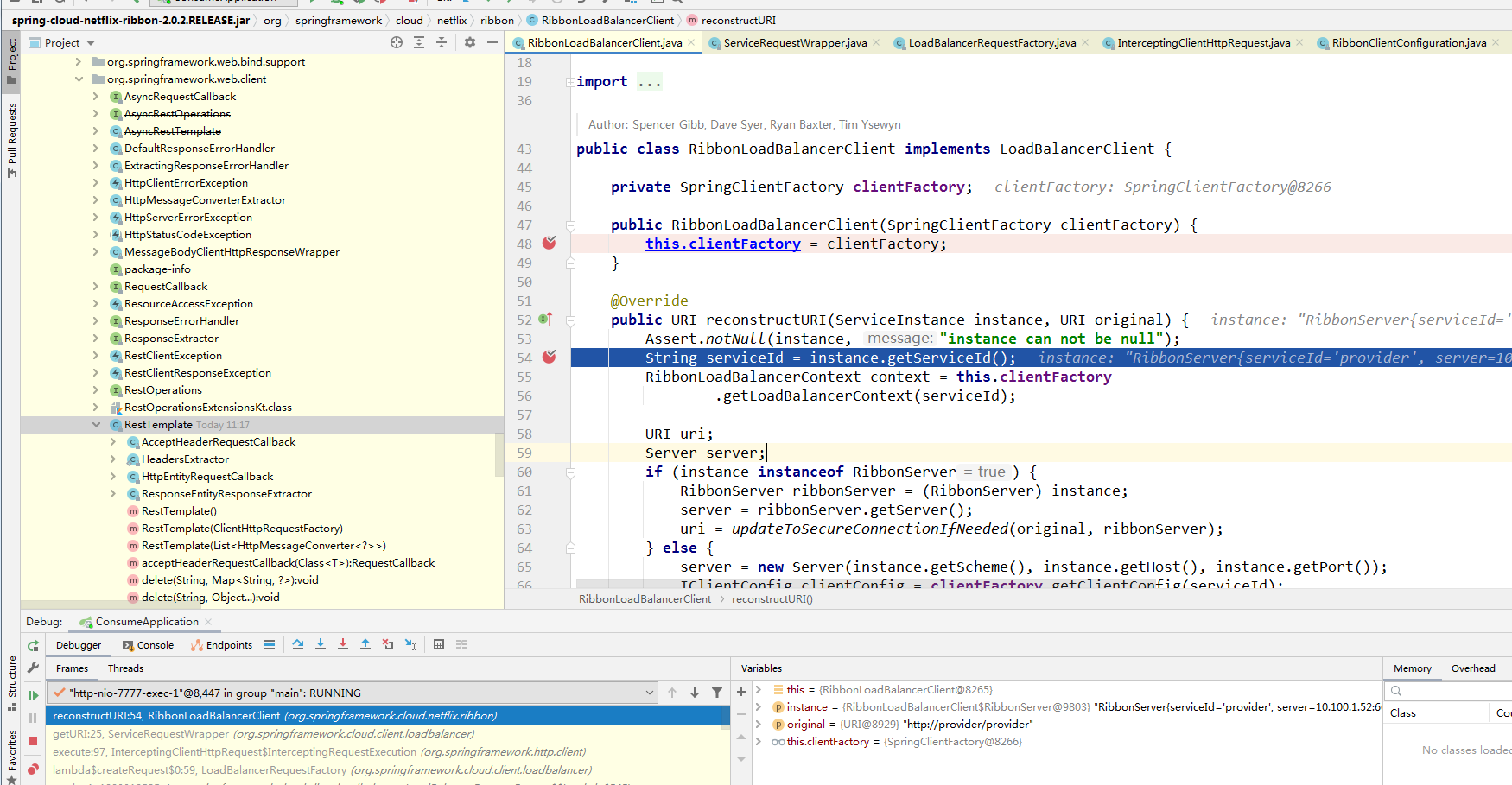
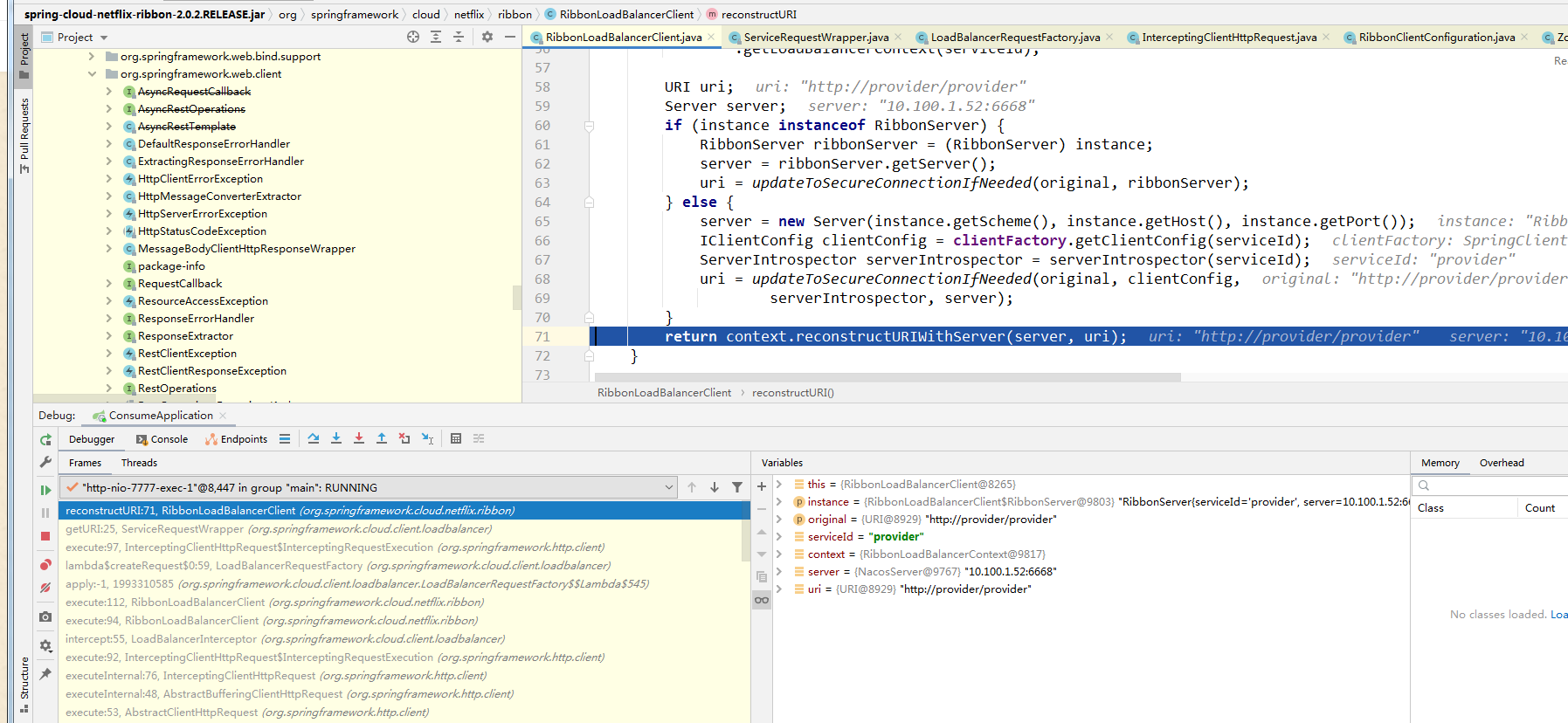
19.
LoadBalancerContext.reconstructURIWithServer
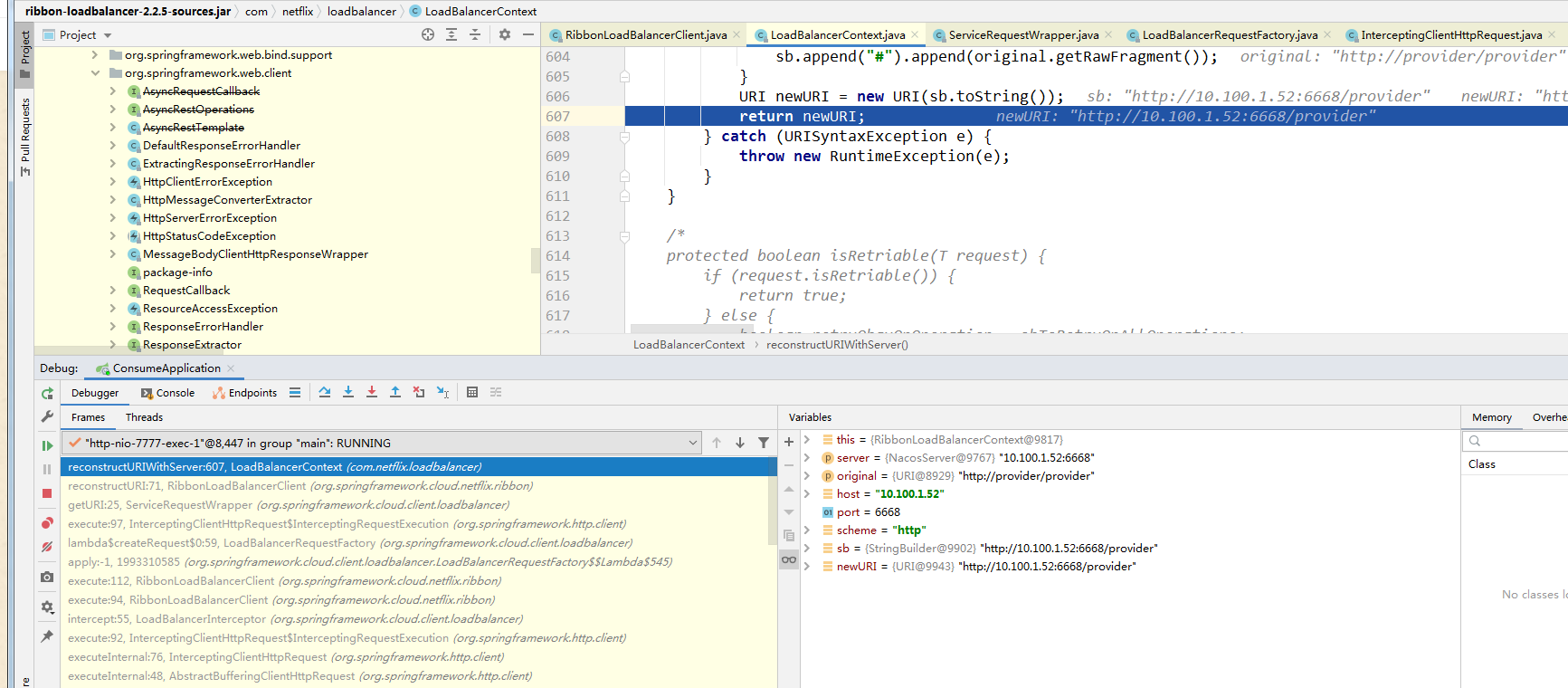
20. After the URL is replaced, call the default HTTP proxy object to initiate a request and return
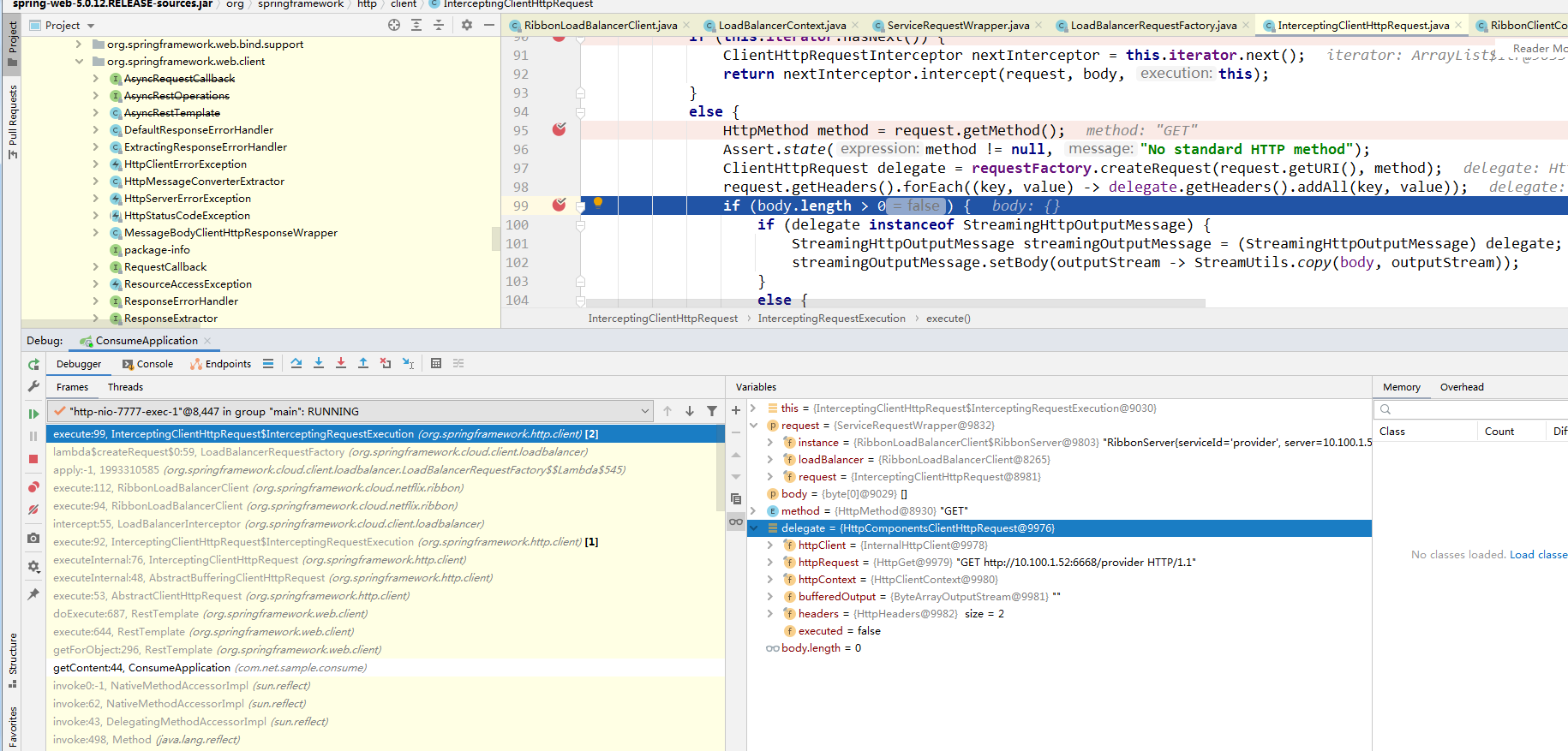
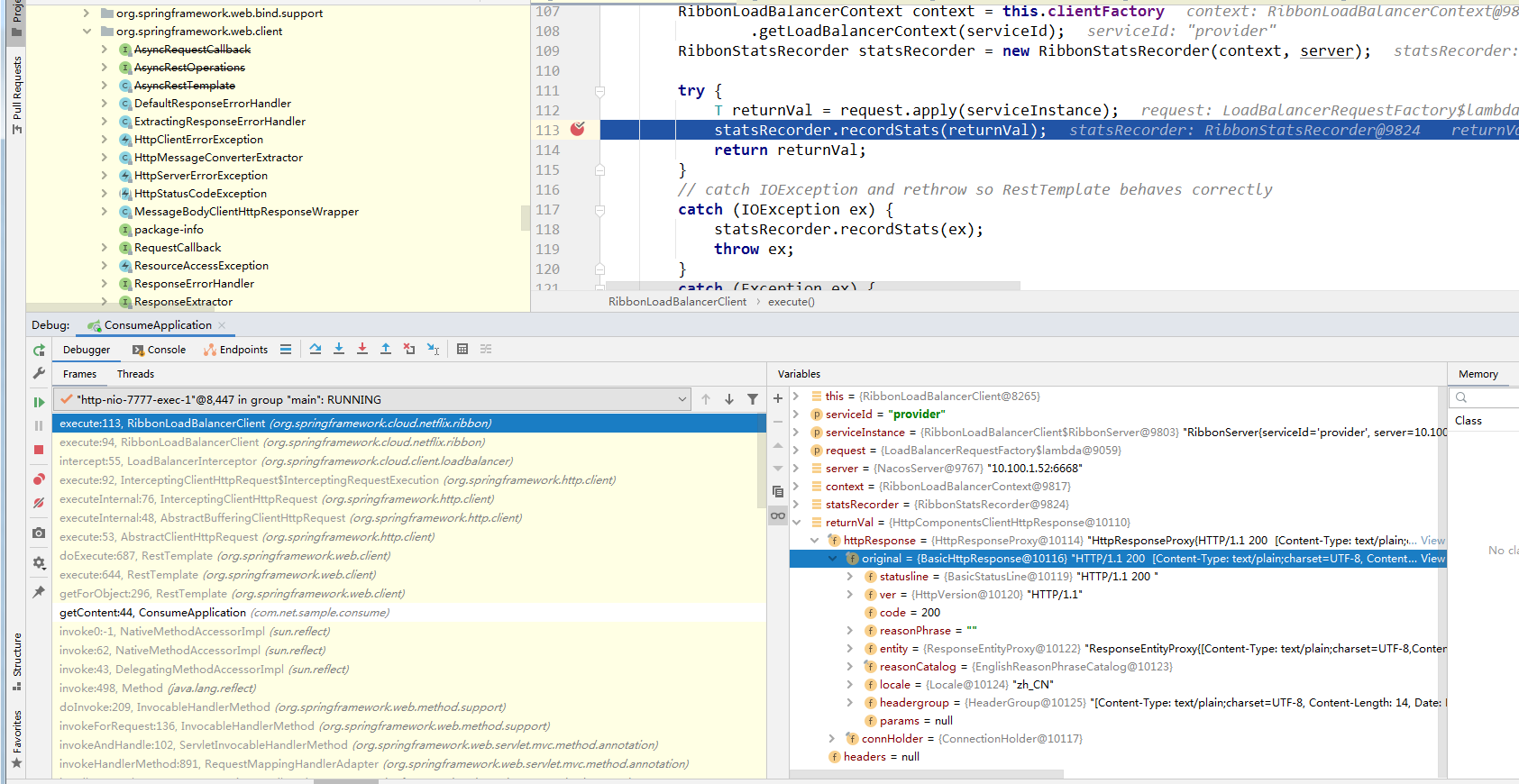
21 when the request ends, the message body conversion is processed and the data is returned.
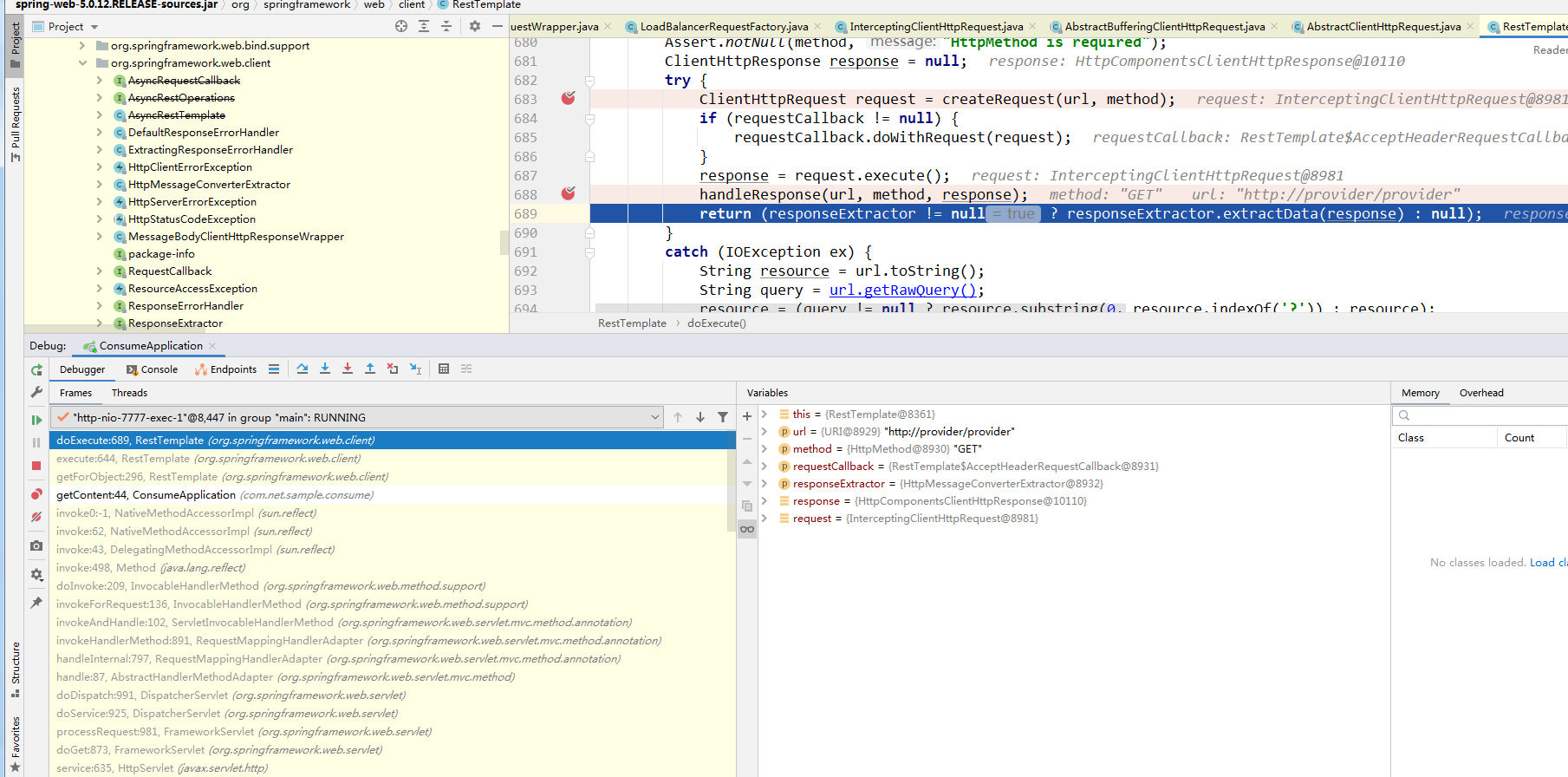
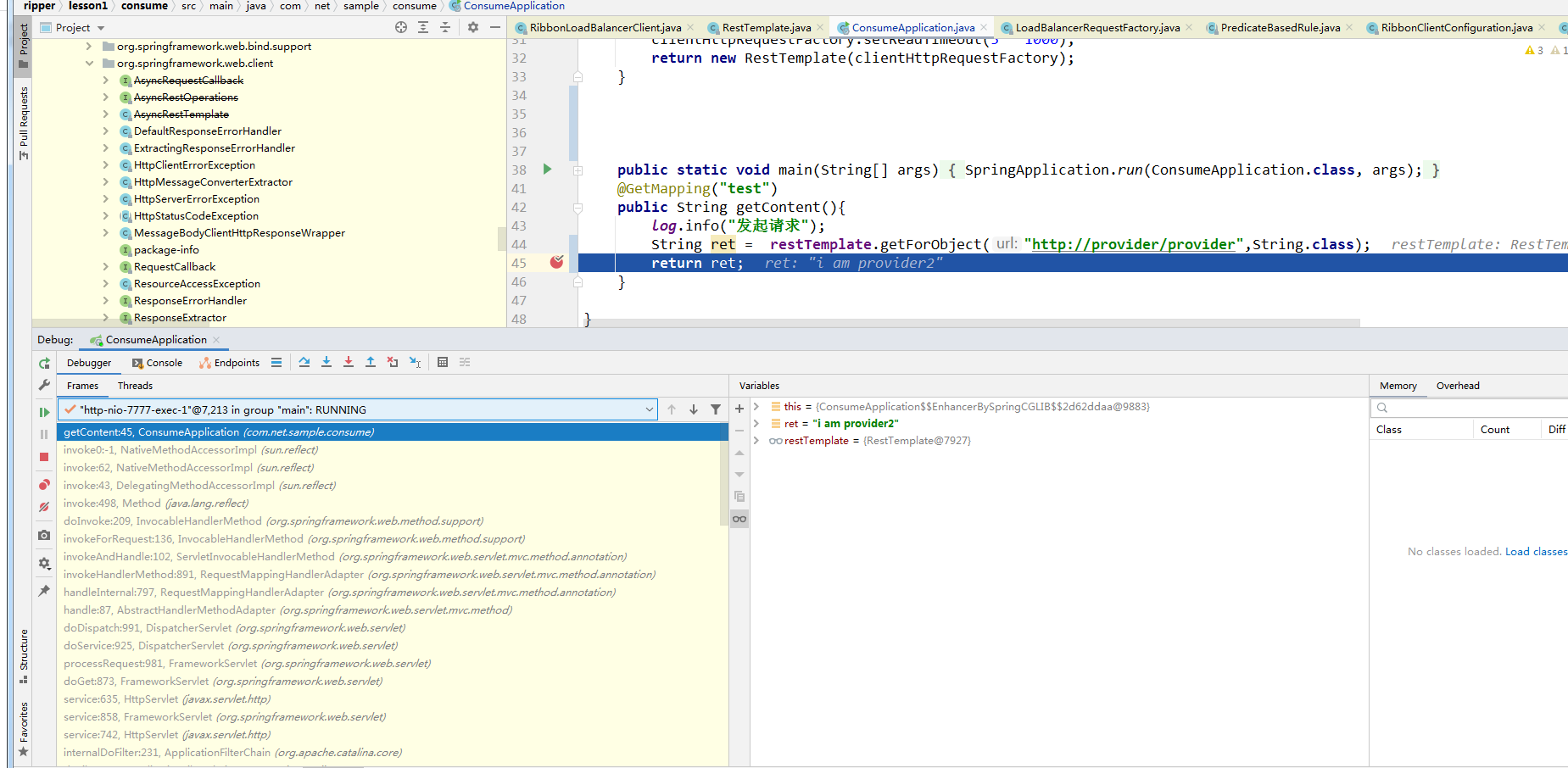
21. Request completed.